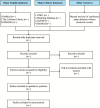The safety and effectiveness of heated humidified high-flow nasal cannula as an initial ventilation method in the treatment of neonatal respiratory distress syndrome: A protocol for systematic review and meta-analysis
- PMID: 33181713
- PMCID: PMC7668501
- DOI: 10.1097/MD.0000000000023243
The safety and effectiveness of heated humidified high-flow nasal cannula as an initial ventilation method in the treatment of neonatal respiratory distress syndrome: A protocol for systematic review and meta-analysis
Abstract
Background: This study uses a method of systematic evaluation to evaluate the safety and effectiveness of heated humidified high-flow nasal cannula (HHHFNC) as an initial ventilation method in the treatment of neonatal respiratory distress syndrome (NRDS) scientifically. In the field of evidence-based medicine, this study provides a theoretical reference and basis for choosing appropriate initial non-invasive ventilation methods in the treatment of NRDS, thereby providing assistance for clinical treatment.
Methods: The main electronic network databases were searched by computer, including 4 Chinese databases: CNKI, WangFang Data, CQVIP, SinoMed and 3 English databases: PubMed, The Cochrane Library and EMBASE, the time range of retrieval from the beginning of each database to September 1, 2020. The content involves all the published randomized controlled trials on the effectiveness of HHHFNC compared with NCPAP as an initial ventilation method in the treatment of NRDS. Using a search method that combines medical subject words and free words. Based on the Cochrane risk bias assessment tool, 2 researchers independently screen the literature, and then extract the data we needed in the literature, and cross-check. If it is difficult to decide whether to include literature, then turning to a third researcher for help and making a final decision after discussion, and using RevMan 5.3 and STATA 13.0 to analyze the relative data.
Results: Based on the method of meta-analysis, this study analyzes the pre-determined outcome indicators through scientific statistical analysis, and compares the effectiveness and safety of HHHFNC compared with NCPAP as an initial ventilation method in the treatment of NRDS. All results will be published in peer-reviewed high-quality professional academic journals.
Conclusion: Based on evidence-based medicine, this study will obtain the establishing evidence of comparison that the clinical effectiveness and safety of HHHFNC compared with NCPAP as an initial ventilation method in the treatment of NRDS through the existing data and data, which provides the evidence support of evidence-based medicine in the treatment of NRDS.
Osf registration number: September 17, 2020. osf.io/f6at4 (https://osf.io/f6at4).
Conflict of interest statement
The authors have no conflicts of interest to disclose.
Similar articles
-
A comparative study of the efficacy and safety of high-flow nasal cannula and nasal continuous positive airway pressure in neonatal respiratory distress syndrome: A protocol for systematic review and meta-analysis.Medicine (Baltimore). 2022 Apr 15;101(15):e29109. doi: 10.1097/MD.0000000000029109. Medicine (Baltimore). 2022. PMID: 35475798 Free PMC article.
-
[Efficacy and safety of heated humidified high-flow nasal cannula for prevention of extubation failure in neonates].Zhonghua Er Ke Za Zhi. 2014 Apr;52(4):271-6. Zhonghua Er Ke Za Zhi. 2014. PMID: 24915914 Clinical Trial. Chinese.
-
Heated, humidified high-flow nasal cannula versus nasal CPAP for respiratory support in neonates.Pediatrics. 2013 May;131(5):e1482-90. doi: 10.1542/peds.2012-2742. Epub 2013 Apr 22. Pediatrics. 2013. PMID: 23610207 Clinical Trial.
-
Heated Humidified High-Flow Nasal Cannula for Preterm Infants: An Updated Systematic Review and Meta-analysis.Int J Technol Assess Health Care. 2019;35(4):298-306. doi: 10.1017/S0266462319000424. Epub 2019 Jul 11. Int J Technol Assess Health Care. 2019. PMID: 31292014
-
The Role of Heated Humidified High-flow Nasal Cannula as Noninvasive Respiratory Support in Neonates.Pediatr Neonatol. 2017 Aug;58(4):295-302. doi: 10.1016/j.pedneo.2016.08.007. Epub 2017 Jan 17. Pediatr Neonatol. 2017. PMID: 28223010 Review.
Cited by
-
High-flow nasal cannula versus continuous positive airway pressure in primary respiratory support for preterm infants: A systematic review and meta-analysis.Front Pediatr. 2022 Nov 21;10:980024. doi: 10.3389/fped.2022.980024. eCollection 2022. Front Pediatr. 2022. PMID: 36479290 Free PMC article. Review.
References
-
- Bi CY. Research progress in etiology and treatment of neonatal respiratory distress syndrome. Chin J Med Device 2019;32:200–1.
-
- Li LQ, Huang HW, Zhang M, et al. Application progress of non-invasive assisted ventilation in the treatment of neonatal respiratory distress syndrome. Chin Foreign Med Treat 2020;39:193–8.
-
- Malloy MH, McGovern JP. Hyaline membrane disease (HMD): an historical and Oslerian perspective. J Perinatol 2018;38:1602–6. - PubMed
MeSH terms
Substances
LinkOut - more resources
Full Text Sources
Medical


